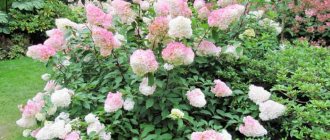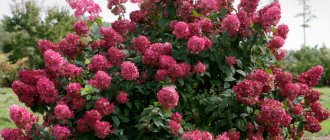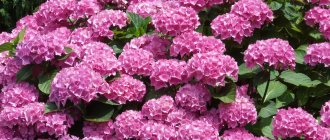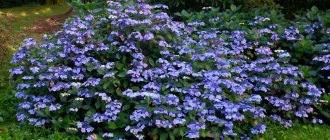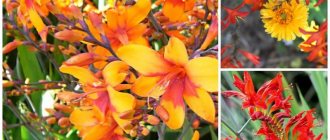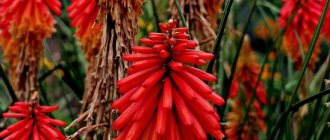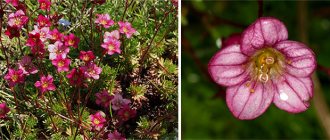- April 19, 2019
- Flowers
- Kristina Degtyareva
Paniculate hydrangeas have long gained popularity among gardeners around the world. Which is not surprising, because these shrubs look just great, and caring for them is not particularly difficult and does not take much time. The heroine of our article today is the delightful hydrangea paniculata Vanilla Fraze. Planting and care, biological description are presented below. Please note: this variety is quite in demand in the southern regions of our country, but experienced gardeners achieve excellent results even in the northern regions.
History of appearance
Vanilla Fraze was developed in France. The breeding was carried out by specialists from a nursery called Renault. The first work began back in 1989. The breeders were faced with a rather difficult task - they had to get a hydrangea that would quickly change its delicate white color to pink. As a result, several plants were obtained. But the final choice fell on Vanille Fraise hydrangea. This happened in 2003.
Biological description of hydrangea Vanilla Fries and photo
This name fully justifies the color scheme of the inflorescences - a combination of white and deep pink shades. The word fraise can be translated from French as “strawberry”. So what is Hydrangea paniculata Vanilla Fraze? The description is amazing: it is a spreading shrub with powerful and elastic shoots, the height of the plant on average reaches from one and a half to two meters. The shoots have a rich burgundy hue. Along the entire length of the branches there are neat oval leaves.
Hydrangea blooms begin in June and can continue until mid-November. The inflorescences are characterized by a pyramidal shape, each about 30 centimeters long. At the same time, initially the petals are white, but closer to August, hydrangea flowers become bright pink. At the beginning of autumn, the pink tone changes to burgundy-red. The plant blooms in the first year after planting in the ground.
Application in landscape design
Huge clusters of inflorescences are very popular in landscape design. Changing over time, hydrangea flowers are unique and therefore used everywhere. The use of this variety in landscaping and space decoration is wide and varied.
Planting in a row for a hedge
As a hedge, of course, the crop is ideal due to the height of shoot growth, the density of the bush and the size of the flowers. This planting option goes well with plants planted in the bottom layer - low-growing green species, against which Vanilla Fries seems like the queen of the garden.
Selection of seedlings
Have you decided to plant Vanilla Fraze hydrangea in your garden? Planting and care are very important stages, but there is something more important. This is the choice of seedling! It depends on which plant you choose how it will bloom and whether it will decorate your site. First of all, you should pay attention to the fact that seedlings on sale come with an open or closed root system. Of course, plants with bare roots are cheaper, but they take root less well. Hydrangea roots should be strong, free of damaged areas and mold.
Transplantation after purchasing Vanilla Frey into open ground
Hydrangea Vanilla Fraze - planting and care in open ground
In order for the flowering of the perennial to be colorful and abundant, you should properly care for the shrub. Planting of bushes should be carried out in spring or autumn. If the seedling was purchased in a tub or pot, it will take root well in the summer.
tree shrub
Lighting and location selection
Hydrangea Vanilla Fries needs good lighting. Compliance with this condition allows you to get large buds and not lose the richness of the color of the inflorescences. The light should be diffused, since exposure to open sunlight on the foliage provokes burns. The foliage will begin to turn yellow and dry out. It is best to give preference to a slightly shaded area.
Soil for growing perennial Vanilla Fraze
The perennial crop prefers slightly acidic, moist soil rich in organic matter. The use of calcareous soil is unacceptable.
Experienced gardeners recommend preparing your own substrate for planting, which will include:
- peat;
- sand;
- humus;
- leaf soil.
Important ! Experts recommend systematically loosening the soil in which the hydrangea is planted to a depth of 6-7 cm.
Don't forget about mulching the soil.
Planting in open ground
Hydrangea Vanilla Fries should not be planted under trees, as they strongly absorb moisture. It is best to plant the shrub in an open area that is protected from direct sunlight. If you ignore this recommendation, the plant will slow down and the inflorescences will be too small.
Boarding order:
- The planting hole in the selected location is filled with fertile soil. If desired, you can add fallen pine needles and a small portion of humus to the soil. It is better to refuse to add ash, since the culture does not really like it.
- The root is buried in the hole so that the root collar is located at ground level. The root system should be evenly distributed, and the root shoots should be carefully straightened.
- The hole is filled with a layer of soil.
- The soil is watered abundantly and mulched using a layer of peat, sawdust or pine needles. It is worth considering that at least 10 liters of water must be poured under each bush.
Important ! The best time to plant a seedling is considered to be the end of May, when the threat of night frosts has passed.
The landing recess is cut out in a square shape. If the soil is too wet, a drainage layer of gravel and broken bricks should be placed at the bottom. To speed up the adaptation process of the seedling, it is worth adding a small amount of growth stimulant to the hole.
Planting hydrangea
To obtain the required percentage of soil oxidation, you should use colloidal sulfur. Under no circumstances should the root collar be allowed to be buried. Along the perimeter of the root system, the soil should fit tightly to the perennial, preventing the appearance of voids.
In cases where Vanilla Fraze bushes are already growing on the site, you should not spend money on buying new ones. You can propagate hydrangea by tilting a heavy mother bush and fixing the selected branch on the ground. By spring, the branch will take root, and the gardener will have a new perennial seedling.
Hydrangea planted in tubs or pots looks quite impressive. To speed up the growth of Vanilla Fraze, it is worth adding a small amount of sand and agroperlite to the soil.
Choosing a place in the garden
In order for Vanilla Fraze to take root on the site and delight with lush flowering for a long time, it is important not only to select seedlings, but also to choose a suitable place. A number of factors should be taken into account: lighting, the presence of other bushes or trees nearby, the presence or absence of wind protection. The ideal option for this variety of hydrangea would be shaded areas, because bright sunlight slows down the growth of the plant and the inflorescences become small.
If your garden does not have a shady area, you can plant hydrangea in the sun, but it will be important to water it frequently and abundantly. Young plants need careful protection from the wind. For such purposes, any buildings, fences or low trees are suitable. You should not plant Vanilla Fraze hydrangea under trees, which absorb all the water. In the northern regions and the middle zone, gardeners recommend planting shoots on the south side.
Use in bouquets
- Place freshly cut hydrangea stems immediately in cold water to prevent wilting.
- Remove the lower leaves on the stems.
- Arrange the stems in a vase and place in a cool place.
- Change the water in the vase daily and spray the flowers with water.
- Soak wilted flowers in cool water for 10 to 15 minutes to revive them.
Soil selection and preparation
Sandy soil is completely unsuitable for this hydrangea, because in it the plant will not receive the nutrients it needs in the required quantity. The best option is neutral soil, but slightly acidic soil is also suitable. If it is still sandy, peat and a large amount of humus should be added to it - this way the soil will retain moisture. Coniferous litter should also be added to any soil. But it is not recommended to use lime, chalk, or ash.
Hydrangea Vanilla Fraze: description of the planting process
Experts recommend planting paniculate hydrangeas of any variety before sap flow begins, in the spring. Autumn planting is also allowed - after leaf fall, but before frost begins.
Boarding order:
- You need to choose a suitable location. A few weeks before planting the shoots, dig a hole, the diameter of which should be 30 centimeters. If you plan to plant several shrubs, maintain a distance of about 1.5–2 meters between them.
- Prepare a special substrate for Vanilla Fraze hydrangea - combine two parts of turf soil and peat with one part of compost and the same amount of sand. Add superphosphate (one plant will need 50 grams) and potassium sulfate (30 grams). To deoxidize the soil, you should add fallen pine needles to it.
- The next stage is pouring the substrate into the hole.
- After one and a half to two weeks, when the soil has settled a little, you can plant hydrangea. The roots of the seedling should be trimmed and then dipped in any growth stimulator for two hours.
- Hydrangea Vanilla Fraze is ready to plant. Place it in the hole, straighten the roots thoroughly and carefully cover it with soil. Water the plant immediately after this.
Types and varieties
The characteristics of varieties depend on the species they belong to.
| View | Description |
| Tree-like | Shrubs growing up to 3 m. Small white buds with a diameter of up to 2 cm are formed on the inflorescence shield. Tree-like varieties bloom in mid-July and grow well in regions with a temperate climate. |
| paniculata | Shrubs or small trees grow up to 5-7 m. Small flowers are collected in panicles, the foliage is distinguished by a rich green tint and a glossy surface on the outer side of the leaf blade. |
| Large-leaved | Hydrangeas of this type stretch up to 4 m. Large-leaved varieties are grown in gardens and indoors. The shade of the petals of large-leaved varieties often changes during the flowering period. |
Hydrangea Vanilla Fraze, a photo of which can be seen in any gardener's reference book, belongs to the category of paniculate hydrangeas. This is one of the most common varieties that people like to plant in their gardens and summer cottages.
In addition to Vanilla Fraze, the following varieties are common:
- Lime light. A variety that produces beautiful voluminous shields. The color of the petal changes over time. At the initial stage, the petals are painted white; by the end of flowering, the petals become milky green.
- Pinky Winky. A variety known for the fact that the color of the petals changes from a calm milky white tone to a bright red color. The visual effect of flowering makes the variety especially in demand. The prolonged blooming of the buds complements the unusualness of the variety: the buds begin to bloom gradually, in tiers, starting from the center of the inflorescence. Full disclosure is achieved in 2 weeks.
- Breinschneider. This variety is represented by large shrubs growing up to 4 m. Shield inflorescences reach a diameter of 15 cm. They are composed of green-white small flowers, which are surrounded by large white buds. A distinctive property of the variety is high frost resistance. This allows it to be grown in regions with difficult climates.
Watering
Like any paniculate hydrangeas, Vanilla Fraze is moisture-loving, and therefore watering should not be skipped. It is recommended to moisten the soil under the bush at least once a week, but this can be done more often if the soil dries out and a hard crust forms on the surface. About ten liters of water need to be poured under one plant. It should be warm and settled. Please note: the root system of hydrangeas is located too close to the surface, and therefore when watering you should make sure that they are not exposed. Immediately after watering, procedures such as loosening and hilling should be carried out. Before a prolonged drought, it is recommended to mulch the soil with humus or peat.
Landing technique
1. First, you need to prepare special holes measuring 30x30x30 cm where the seedlings are placed.
Note! Plants should be spaced more than 1 meter apart.
2. Fill the finished holes with a special mixture (peat, half a bucket will be enough + compost).
3. Water the resulting hole with water.
Now you can transfer the seedlings into the formed holes.
1. Sprinkle special garden soil on top.
Note! Under no circumstances should the root collar be covered with soil.
2. Compact all the soil around the roots
3. Water the resulting holes and loosen the top layer of soil
4. When planting in hot or sunny weather, provide shelter for the seedlings. This way you will protect them from possible burns.
Fertilizer application
What other procedures are important for shrubs after planting? Hydrangea Vanilla Fraze and its care cannot be imagined without feeding. Nutrients such as organics or mineral complexes are best. Gardeners recommend alternating different types of fertilizers. There is a scheme that should be followed when feeding paniculate hydrangeas:
- kidney swelling;
- the appearance of buds;
- mass flowering;
- preparation for cold weather.
The first feeding, which is carried out at a time when the hydrangea's buds are gaining strength, should be organic. For one part mullein you will need 15 parts water. This solution should be watered directly to the roots of the bushes.
For summer feeding, you should choose mineral complexes. You can purchase ready-made formulations or prepare the fertilizer yourself. This will require 30 grams of potassium salt, ammonium nitrate and superphosphate. The resulting mixture should be dissolved in water. In the fall, it is necessary to “pamper” the plant with potassium sulfate and superphosphate - 30 grams per bush. Please note: before winter you should not apply nitrogen-based fertilizers - otherwise the Vanilla Fraze hydrangea will begin to grow vigorously.
Correct location
Since hydrangea is completely unpretentious , it can be placed anywhere: be it in fully illuminated areas or in partial shade. The same goes for Vanilla Fraze. However, it is worth noting that this variety prefers to be in the shade than to fry in the sun. Don't think that Vanilla Fraze will die in the sun. No, she will still be comfortable, she will just grow slower because of this. You will notice this in the summer, when your bush will still seem young and short, and the inflorescences will not spread widely, as they promise on the Internet. Limestone soil can also prevent Vanilla Fraze from growing peacefully, so be careful.
Here are some important conditions for the soil in which Vanilla Fraze will be grown.
It should be:
- Always wet
- Bioorganic
- Loose
- Fertile
- Have a slightly acidic or neutral reaction.
If you decide to grow your hydrangea in the shade, as it requires, be prepared to periodically loosen the soil around the roots.
Note! For those who do not have the time and desire to loosen the soil every time, there is a life hack. Mulching will save you! Simply cover the surface layer with some material (be it hay or a canopy).
Trimming
Pruning is necessary in order to give the lush, spreading shrub a neat shape. This event should be carried out in early spring, before the process of sap flow begins. First of all, dry and damaged branches should be removed. The next stage is pruning each shoot.
Pruning will also help to rejuvenate an adult hydrangea - 5-7 branches, the height of which is about 10 centimeters, should be left above the surface of the ground. In summer, paniculate hydrangea should not be trimmed, but dry inflorescences must be removed so that new buds appear.
Features of transplantation
The optimal time for transplantation is autumn.
But to carry out transplantation, you must adhere to the following instructions:
- In spring, you need to make a ditch 30 cm deep and wide around the bush.
- Add compost to it and water it constantly.
- The paniculate hydrangea will begin to take root in this ditch, and accordingly, it will be easier to replant it.
- In autumn, shrubs are dug around the resulting ditch.
- Then the hydrangea is removed from the ground.
- At the same time, it is important to monitor the integrity of the new roots.
- Next, the resulting planting material is planted in the prepared place. Pruning done in advance will help the plant take root.
Protecting plants from pests and diseases
Hydrangea Vanilla Fraze is quite resistant to diseases and pests. One of the few dangers is fungal diseases. If the summer is rainy and cool, the shrub may be affected by rot and powdery mildew. To protect hydrangea, you should promptly treat it with solutions prepared on the basis of fungicides. Gardeners recommend paying attention to such preparations as Topaz, Fundazol, Fitosporin. Hydrangea can also get sick if it lacks nutrients. In such a situation, chlorosis may begin. Identifying the disease is quite simple: it is characterized by symptoms such as yellowing of leaves, their curling and falling. Fertilizers that contain iron will help fight chlorosis.
Vanilla Fraze can attract various pests that feed on the sap of the bush. So if your hydrangea begins to dry out, its leaves fall off, and its growth slows down, check to see if the plant is infected with spider mites or aphids. It is possible that the hydrangea was attacked by snails. What to do if you find pests? First of all, you should use insecticides. “Akarin” and “Tanrek” are perfect. As a preventative measure, experts recommend using folk remedies - infusions prepared with garlic or onion peels.
Hydrangea care
Regular care ensures the formation of lush inflorescences of the Vanilla Fraze variety. The shrub is cared for by watering and fertilizing. Pruning the shoots helps give the bush the desired shape. To protect against diseases and pests, special preparations or folk remedies are used.
Watering
Paniculata hydrangea is moisture-loving, so watering is an essential step in caring for it. The soil under the bush is moistened every week, preventing it from drying out and forming a crust on the surface.
Important! Up to 10 liters of water are added under the Vanilla Fries panicle hydrangea bush.
For irrigation, use only warm, settled water. During drought, the shrub is watered more often, up to 2-3 times a week.
The root system of hydrangea is located close to the surface of the earth. Therefore, when watering, make sure that its roots are not exposed. After adding moisture, loosen the soil and hill up the shrubs. Mulching the soil with peat or humus helps reduce the number of waterings.
Feeding
To form lush inflorescences of Vanilla Fraze hydrangea, a supply of nutrients is required. The shrub is fed with organic matter or mineral complexes. The best results are obtained by alternating different types of fertilizing.
Panicle hydrangea Vanilla Fries is fed according to the following scheme:
- in spring when the buds swell;
- when the first buds appear;
- during the period of mass flowering;
- in the fall in preparation for winter.
For the first feeding of the Vanilla Fraze variety, an organic fertilizer based on mullein is prepared. Organics are mixed with water in a ratio of 1:15. The resulting solution is watered at the roots of the bushes.
Summer treatments are performed using mineral complexes. The fertilizer is prepared independently by combining ammonium nitrate, superphosphate and potassium salt. Each substance is taken in an amount of 30 g, after which they are dissolved in water.
Ready-made mineral complexes in the form of dry granules and suspensions have been developed for hydrangea. This fertilizer must be dissolved in water, and then water the bushes at the root.
Autumn feeding of the Vanilla Fraze variety is carried out using superphosphate and potassium sulfate. 30 g of each substance is added to each bush. Fertilizers containing nitrogen should be abandoned in the fall so as not to cause increased shoot growth.
Trimming
By pruning, Vanilla Fraze hydrangeas are given the desired shape. The bushes are pruned in early spring before the sap flows. Be sure to remove dry and broken branches.
Each shoot is shortened to 6-8 buds. In total, 5-10 branches are enough per bush.
Advice! Pruning shoots at the root helps to rejuvenate old shrubs. Branches no longer than 10-15 cm are left above the surface.
In summer, Vanilla Fries hydrangea is not pruned. However, it is necessary to eliminate dry inflorescences, which leads to the formation of new buds.
Protection from diseases and pests
Hydrangea Vanilla Fraze can be seriously affected by fungal diseases. In cold, rainy weather, plants are susceptible to powdery mildew and various rots. The lesion covers the shoots and leaves of the bush.
To protect hydrangea from diseases, solutions based on fungicides are prepared. The drugs Fundazol, Fitosporin, Topaz have good medicinal properties. Preventive spraying is carried out in early spring and late autumn.
If there is a lack of nutrients, the Vanilla Fraze variety is susceptible to chlorosis. The disease is identified by yellow leaves that begin to curl and fall off. To combat the disease, the shrub is fed with a complex fertilizer containing iron.
Attention! Paniculata hydrangea attracts pests: snails, aphids, spider mites. All of them feed on plant sap, as a result of which the leaves dry out and fall off, and the development of the bush slows down.
For insects, the bush is sprayed with solutions using insecticides Tanrek or Akarin. Folk remedies are suitable for prevention: infusions of onion peels or garlic. They are used for processing at any stage of bush development.
Shelter for the winter
Hydrangea Vanilla Fries can withstand harsh winters. When grown in the southern regions and the middle zone, the shrub is not covered.
In cold, snowless winters, mulching the soil with peat or humus helps protect hydrangeas from freezing. The thickness of the mulch is from 20 to 30 cm.
Young plants must be covered for the winter with agricultural material or burlap. When snow falls, a snowdrift is thrown over the bushes for additional insulation.
Preparing for winter
With proper care and preparation for cold weather, paniculate hydrangea of this variety can survive frosts down to -35 degrees! Therefore, in the southern zone, Vanilla Fraze does not need to be covered for the winter. Gardeners from central Russia or northern regions are recommended to protect the plant from freezing by mulching the soil. The thickness of humus or peat mulch should be at least 20 centimeters. In the first two years after planting, hydrangea should be covered with special agricultural material (burlap can be used instead). After snow falls, gardeners recommend throwing a small snowdrift over the bush in order to further insulate it.
Reviews from gardeners
Marina from Lipetsk says about the “Vanilla Fries” hydrangea: “This flower has indescribable beauty. I saw it at a neighbor's house and she gave me a few branches. I first planted it in a pot and planted it in the garden in May. That same year, the hydrangea bloomed white and pink. It looks very nice on the site.”
Nadezhda from Tambov says: “Hydrangea looks gentle and neat. I like that I don't have to dig it up for the winter. I planted it once and forgot for several years. The only thing that needs to be observed is regular and abundant watering. Otherwise, the shrub does not require special care.”
Reproduction
There are two ways to propagate this delightful shrub. The first is cuttings. It should be carried out in the spring: you need to carefully cut off several shoots (of course, along with the buds), and then dip them in any growth stimulator. Immediately after this, the cuttings can be planted in a flowerbed, and after they take root, they can be planted in a permanent place. Another way is to use so-called layering. At the beginning of spring, the lower shoots should be cleared of leaves and secured to the ground, sprinkled with fertile soil. By autumn, the cuttings will have taken root, which means you can replant them.
Propagation methods for the Vanille Fraise variety
The shoots remaining after pruning can be cut into cuttings; last year's branches and young growth are suitable. Each cutting will consist of a section of shoot 12-15 cm long with two paired buds and leaves. Prepare the soil for further deepening, in the meantime, send the cuttings to the rooting stimulator. After 2-3 hours, remove the cuttings from the water, remove the lower leaves on each of them, and shorten the upper leaves to 1/3. After planting in the soil, cover the pots with jars or bottles, remembering to ventilate them daily. In a month you will receive finished material, ready for transplanting into open ground.
If you are interested in growing Vanilla Frazee hydrangea from scratch, in order to experience the delights of planting and caring for the plant to the fullest, try growing a shrub from seeds. This is a long process, but there is nothing complicated about it. A full-fledged flowering bush will be ready in 3-4 years.
To obtain seedlings, you can also use the methods of dividing the bush and removing the shoot from the mother plant. Division is only advisable when moving the hydrangea to another place; in this case, prepare for a long recovery period. A cutting is a shoot buried next to the main bush. This is done like this: a shallow cut is made across the vine, which, when buried, is directed downwards - from here roots will begin to develop. The buried shoot is left until the next season; a year later in the fall, the young plant is separated from the mother bush, now it can be planted separately.
